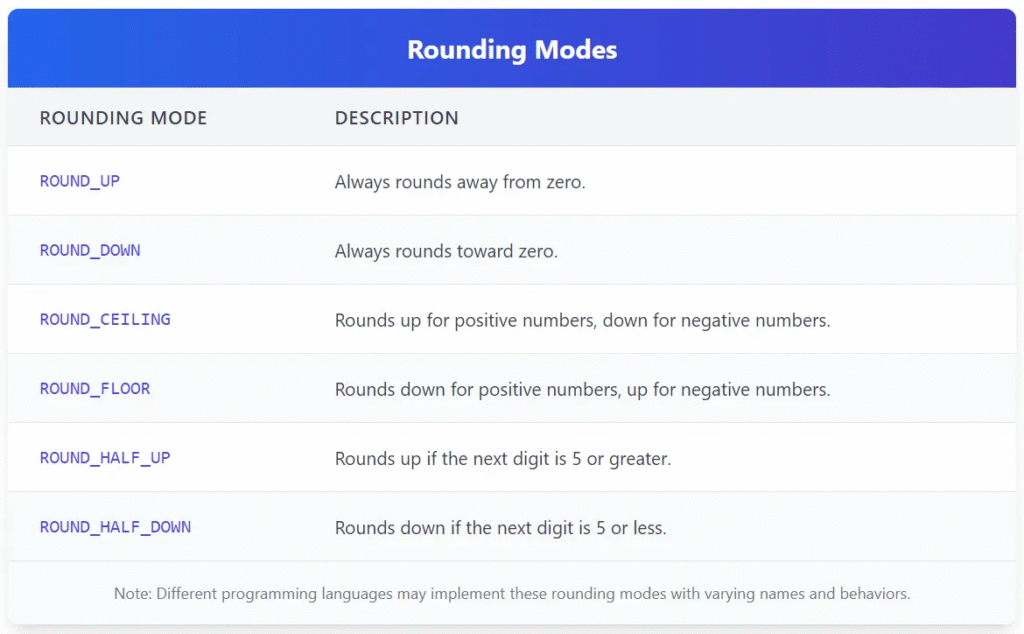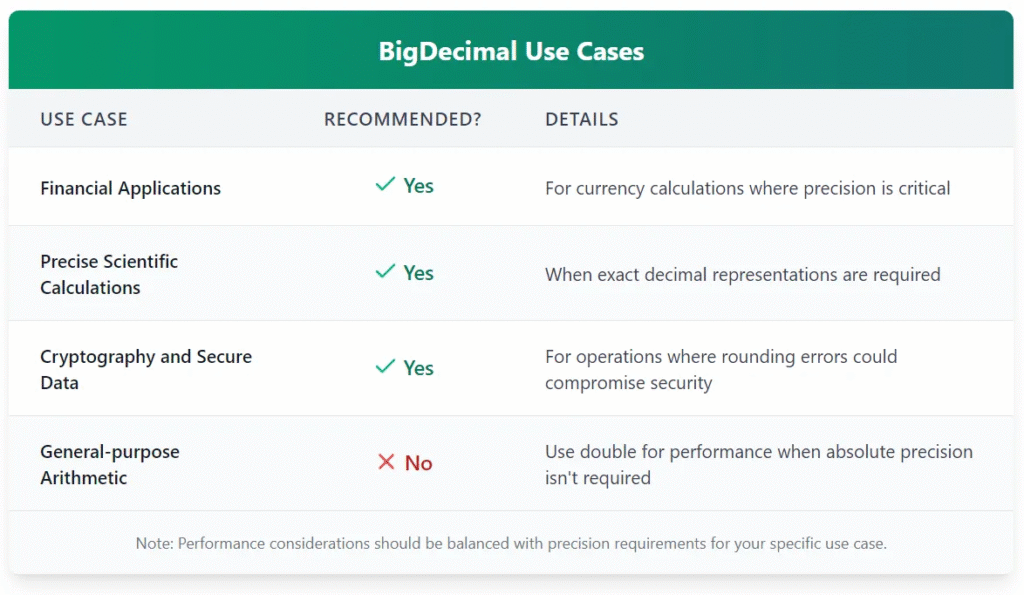Java’s BigDecimal Class is a powerful tool for handling high-precision arithmetic. Unlike primitive data types like float and double, which suffer from rounding errors due to floating-point representation, BigDecimal provides an exact representation of decimal numbers, making it ideal for financial calculations, scientific computing, and other applications requiring precision.
This tutorial will cover everything developers need to know about BigDecimal, including its creation, operations, comparison, rounding, and best practices.
1. What is BigDecimal?
The BigDecimal Class is part of java.math and is designed to handle numbers with arbitrary precision. It is helpful in scenarios where precision is crucial, such as:
- Financial calculations: Dealing with money and currency conversion.
- Scientific calculations: Where precision errors could lead to incorrect results.
- Cryptography and data security: Where precise values are essential.
2. Creating BigDecimal Objects
Unlike primitive numeric types, BigDecimal objects must be instantiated explicitly. There are multiple ways to create an instance BigDecimal:
Using String Constructor (Recommended)
import java.math.BigDecimal;
public class BigDecimalExample {
public static void main(String[] args) {
BigDecimal bd1 = new BigDecimal("123.456");
System.out.println("BigDecimal using String: " + bd1);
}
}Why use Strings?
Using new BigDecimal("123.456") avoids precision errors that can occur when using double values.
Using double (Not Recommended)
BigDecimal bd2 = new BigDecimal(123.456);
System.out.println("BigDecimal using double: " + bd2);⚠️ Issue: This approach can introduce precision errors because double does not store exact decimal values.
Using valueOf() (Preferred for doubles)
BigDecimal bd3 = BigDecimal.valueOf(123.456);
System.out.println("BigDecimal using valueOf(): " + bd3);This method converts a double to a BigDecimal safely.
3. Basic Operations
Addition
BigDecimal num1 = new BigDecimal("10.5");
BigDecimal num2 = new BigDecimal("2.5");
BigDecimal result = num1.add(num2);
System.out.println("Addition: " + result); // Output: 13.0Subtraction
BigDecimal result = num1.subtract(num2);
System.out.println("Subtraction: " + result); // Output: 8.0Multiplication
BigDecimal result = num1.multiply(num2);
System.out.println("Multiplication: " + result); // Output: 26.25Division
Division requires specifying a rounding mode to prevent ArithmeticException (when the result is non-terminating).
BigDecimal result = num1.divide(num2, 2, BigDecimal.ROUND_HALF_UP);
System.out.println("Division: " + result); // Output: 4.20- The second argument (
2) specifies the scale (number of decimal places). ROUND_HALF_UPFollows the standard rounding rule.
4. Comparing BigDecimal Objects
Using compareTo() (Preferred)
BigDecimal a = new BigDecimal("10.50");
BigDecimal b = new BigDecimal("10.500");
if (a.compareTo(b) == 0) {
System.out.println("Both numbers are equal.");
} else {
System.out.println("Numbers are different.");
}Even though 10.50 and 10.500 look different, compareTo() considers them equal.
Using equals() (Not Recommended for Value Comparison)
if (a.equals(b)) {
System.out.println("Equal");
} else {
System.out.println("Not Equal");
}⚠️ Issue: equals() compares scale as well, so 10.50 is not equal to 10.500.
5. Rounding Modes
BigDecimal supports multiple rounding modes when reducing precision. The most common ones are:

Example: Rounding a BigDecimal
BigDecimal number = new BigDecimal("12.5678");
BigDecimal rounded = number.setScale(2, BigDecimal.ROUND_HALF_UP);
System.out.println("Rounded Number: " + rounded); // Output: 12.576. Handling Precision and Scale
Setting Scale Explicitly
BigDecimal preciseNumber = new BigDecimal("123.4567").setScale(2, BigDecimal.ROUND_HALF_UP);
System.out.println(preciseNumber); // Output: 123.46Why is scale necessary?
In financial applications, setting the correct scale ensures consistent calculations.
7. Converting Between Types
BigDecimal to int, double, and String
BigDecimal bd = new BigDecimal("123.45");
int intValue = bd.intValue();
double doubleValue = bd.doubleValue();
String stringValue = bd.toString();
System.out.println("int: " + intValue);
System.out.println("double: " + doubleValue);
System.out.println("String: " + stringValue);String to BigDecimal
BigDecimal fromString = new BigDecimal("999.99");
System.out.println(fromString);8. Best Practices for Using BigDecimal

9. When to Use BigDecimal?

BigDecimal is slower than double because it involves object creation and more complex calculations. Use it only when precision is necessary.
Conclusion
The BigDecimal A class in Java is essential for applications requiring precise calculations. By following best practices and understanding how to use BigDecimal them correctly, developers can avoid common pitfalls and ensure accurate results in financial, scientific, and mathematical computations.



